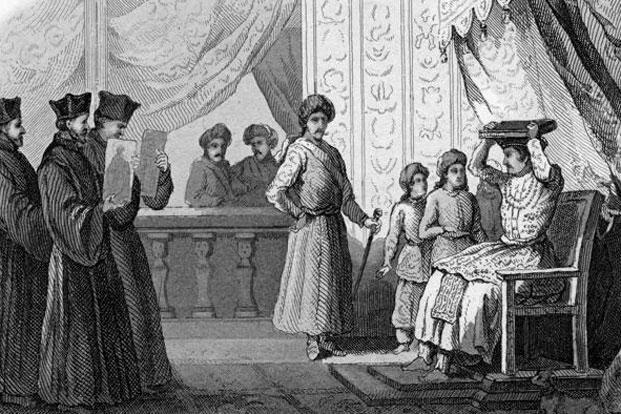Book Excerpt: The First Farangis by Jonathan Gil Harris
 WHAT EXACTLY is the harem? Perhaps the most accurate answer is that it is a space of Western fantasy. ‘Harem’ is the English rendering of the Arabic ‘haram’, meaning sanctuary; haram is also related to ‘harim’, meaning the female members of the family, and ‘haraam’, meaning forbidden. But the connotations of the Arabic term ‘haram’ have been displaced by the rather different referent of the English word ‘harem’, which names not just a physical space but also the large female retinue owned by a Muslim sultan or emperor for his sexual pleasure. As a result, the space of the harem has morphed into something rather different in the Western imagination from what the haram was in reality. This is as true of the Mughal harem as it is of the even more famous Imperial Harem of Topkapi Palace in Istanbul. Like Rushdie’s Jodha Bai, the Mughal harem has largely been fleshed out in the colours of men’s dreams.
WHAT EXACTLY is the harem? Perhaps the most accurate answer is that it is a space of Western fantasy. ‘Harem’ is the English rendering of the Arabic ‘haram’, meaning sanctuary; haram is also related to ‘harim’, meaning the female members of the family, and ‘haraam’, meaning forbidden. But the connotations of the Arabic term ‘haram’ have been displaced by the rather different referent of the English word ‘harem’, which names not just a physical space but also the large female retinue owned by a Muslim sultan or emperor for his sexual pleasure. As a result, the space of the harem has morphed into something rather different in the Western imagination from what the haram was in reality. This is as true of the Mughal harem as it is of the even more famous Imperial Harem of Topkapi Palace in Istanbul. Like Rushdie’s Jodha Bai, the Mughal harem has largely been fleshed out in the colours of men’s dreams.
Foreign men were barred entry into the Mughal harem. As a result, it became the object of fevered speculation among them. Travellers to Hindustan widely supposed the harem to be a space in which nymphomaniac wives and slave-girls, overseen by eunuchs, serviced the gargantuan sexual needs of the emperor. The Englishman William Finch imagined Jahangir in the harem ‘like a cock of the game’, where he ‘may crow over all’; his countryman Thomas Coryate believed that Jahangir kept there ‘a thousand women for his own body’, while others estimated the figure to be closer to three or even five thousand. Such fantasies conjured up a sexually overheated den of vice. But other Europeans imagined the Mughal harem as a temperate paradise more in the vein of Shangri-La or the Garden of Eden. The French Jesuit François Catrou claimed that the Mughal harem had ‘running streams, shadowy groves, fountains and subterraneous grottos’, all built with the purpose of ‘securing a delicious coolness’. His assessment was based on several other European visitors’ reports. Yet in both guises—as den of sexual depravity and as idyllic paradise—the harem was supposed to be completely external to the male world of politics and, indeed, history.
Such assumptions were based largely on surmise and bazaar gossip. After all, very few firangi men ever got to see the harem. One or two foreign physicians were admitted to treat ailing Mughal women; but even their supposedly eye-witness accounts draw more on others’ fantasies than on actual observation of the culture of the harem. Niccolò Manucci, who briefly served as a physician in Shah Alam’s retinue, notes that the custom was for eunuchs to lead an attending doctor into the royal female apartments with his head and eyes fully covered by a shawl. As a result, Manucci never saw the women he treated. But he offers for his readers’ titillation the news that the harem women would ‘kiss…and softly bite’ his hand. Similarly, Aurangzeb’s French physician François Bernier says that he was led into the harem with a Kashmir shawl covering his head, which prevented him from seeing anything. Nevertheless, he confidently asserts, like Catrou, that the space was full of ‘gardens, delightful alleys, shady retreats, streams, fountains, grottoes’. Such descriptions helped reinforce the Western canard that the harem was an over-sexed paradise for the emperor’s private enjoyment, completely cut off from the public sphere.
Yet the historical evidence indicates that the Mughal zenana was neither simply a nest of sexual vice nor a self-enclosed private space. Nor was it an institution immune to historical change. In the time of Babur and Humayun, when the Mughals still retained vestiges of the nomadic culture of their ancestors, the haram, like the court, was a collection of portable tents that housed the emperor’s royal female relatives as well as wives and slave-girls. It was only in Akbar’s time that it transformed into a permanent bricks-and-mortar structure incorporated into a royal palace. Humayun’s tent-haram was much smaller than Akbar’s palatial zenanas in Fatehpur Sikri, Lahore and Agra; Abu’l Fazl claims that these housed up to 5,000 women. But the Mughal emperor hadn’t suddenly discovered the pleasures of unbridled promiscuity. The sharp increase in the zenana’s population was because Akbar, in a deliberate programme of empire-building, married numerous women from Persia, Rajasthan, and elsewhere to secure political alliances with potentially troublesome warlords and rajas. Not all of these ‘wives’ ended up sharing Akbar’s bed. Yet all of them came with their own female family members and servants. And many of the wives, sisters, and mothers of Akbar’s high-ranking courtiers were also housed in the royal zenana.
Pages 152-154
